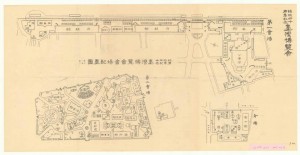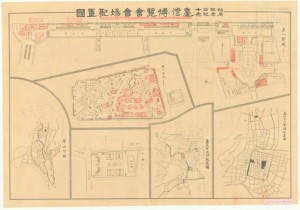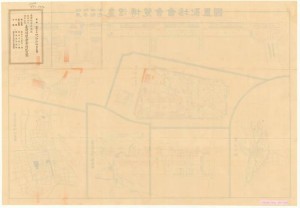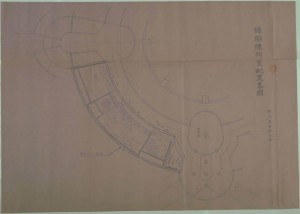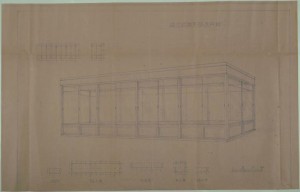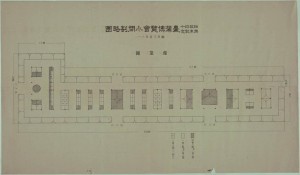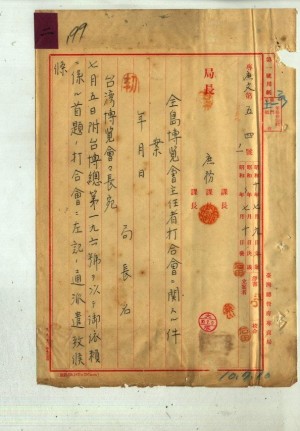TELDAP Collections
| Taiwan’s Most Prominent Exposition |
|
The year 1935 marked the 40th anniversary of Japanese colonization in Taiwan. To show how far Taiwan had progressed under its rule, the colonial government decided to host a large-scale exposition called “The Taiwan Exposition: 40th Anniversary of Governance.” As many as 2,000 people from the government and citizens of Taiwan were called into action after the Governor-General’s Office initiated the preparation work. The funding came partially from the Governor-General’s Office and partially from donations by notable persons from business and political circles. After about a year of preparation, the exposition took place from October 10th to November 28th in 1935. The exposition lasted for nearly two months and was aimed at displaying Taiwanese and Japanese products as well as construction development. Besides introducing exotic goods exclusive to Taiwan, the exposition also strove to convey the concept of modernization. A fine assortment of produce and crafts, along with landscape models, lit up the 30-plus exhibition buildings designed for the occasion, showcasing the nation’s political, economic and cultural power. The first exhibition area was located between the Taipei City Public Auditorium and Sanxian Road in Taipei City (now Zhonghua Road and Taipei Zhongshan Hall), featuring Taiwan’s agriculture, forestry, sugar and mining industries. Also displayed in the hall were achievements in railway construction and urban planning, as well as telecom and postal services in Taiwan. Brief profiles of the other colonies of Japan, such as Korea and Manchuria, were also on display. The Japanese businesses Nippon Steel Corp. and Mitsui & Co., Ltd were among the exhibiting companies. The second exhibition venue was at the Taipei New Park (now known as the 228 Peace Memorial Park), and was divided into the Exhibition Section and the Recreation Section. The Exhibition Section presented Taiwan’s cultural development during the 40 years of Japanese rule, Japanese military defense equipment, boats and vessels, Taiwanese electronic devices and monopolized facilities. Furthermore, items from Tokyo, Osaka, Kyoto, Nagoya and Hokkaido were provided for visitors to behold. The Recreation Section featured a music hall, a performance hall, a theater, an aquarium, a children’s playground and a dining hall. The Dadaocheng Southern Exhibition Hall was located near the Taiping Public School (now called Taiping Elementary School). This section offered an overview of the situations in southern China and Southeast Asia, and displayed special products produced by the Fujian Provincial Government and by the Philippines and Thailand. In addition, there was also an Equestrian Room open for visiting, and a Performance Room set up for the staging of Chinese traditional drama. Another exhibition venue was the Grass Mountain Exhibition Hall located in the Beitou hot springs area. It showed Taiwan’s famous tourists attractions, blueprints for the future Datun National Park (now known as the Yangmingshan National Park) and images of Japanese national parks. Alongside the exhibitions, many large-scale activities were held, such as the Beigang Mazu Tour, sports events, industry conferences, as well as contests in poetry, calligraphy, and painting. Teams from Taiwan, Korea, and Manchuria all joined the track and field competitions. Baseball games were played. Various recreational performances were staged—singing and dancing, traditional plays, Chinese Beijing opera, modern plays, and acrobatics. Parades and fireworks displays took place as well. According to the number of admission tickets issued during the exhibition, the amount of entries into the exhibition halls totaled to over 2,750,000, with the estimated number of visitors being over a million. Among them, hundreds of thousands of people from across Taiwan came to Taipei by train just to witness the magnificent event. It follows logically that the Governor-General’s Office took the Exposition as a chance to show off the overall performance of its colonial administration. To the Taiwanese, there was no denying that the Exposition was a lively carnival with novelties that impressed the eye. Collection of Related Items[Exhibition Site of The Taiwan Exposition: 40th Anniversary of Governance] Description: preservation condition: good Identification number: 00103499001 - 00103341000019002001M
[Exhibition Site of The Taiwan Exposition: 40th Anniversary of Governance] Description: preservation condition: good Identification number: 00103499001 - 00103341000019002002M
[Exhibition Site of The Taiwan Exposition: 40th Anniversary of Governance] Description: preservation condition: good Identification number: 00103499001 - 00103341000019002003M
[The Taiwan Exposition: 40th Anniversary of Governance] Description: preservation condition: good Identification number: 00103499002 - 00103341000029002001M
[Exhibition Site of The Taiwan Exposition: 40th Anniversary of Governance] Description: preservation condition: good Identification number: 00103499002 - 00103341000029001001M
[Exhibition Site of The Taiwan Exposition: 40th Anniversary of Governance] Description: preservation condition: good Identification number: 00103499002 - 00103341000029002002M
[Exhibition Site of The Taiwan Exposition: 40th Anniversary of Governance] Description: preservation condition: good Identification number: 00103499002 - 00103341000029001003M
[Exhibition Site of The Taiwan Exposition: 40th Anniversary of Governance] Description: preservation condition: good Identification number: 00103499002 - 00103341000020206M
Description: preservation condition: good Identification number: 00103499002 - 00103341000020286M
|






